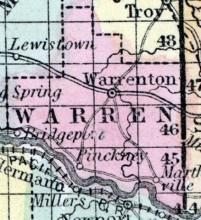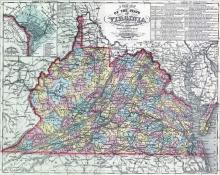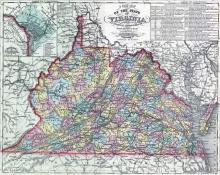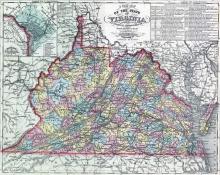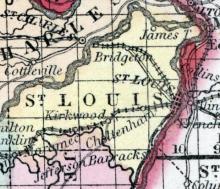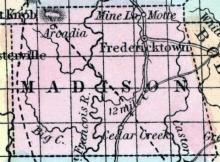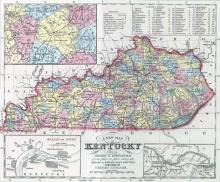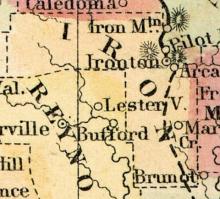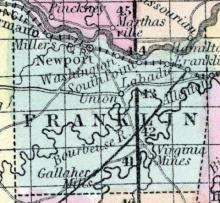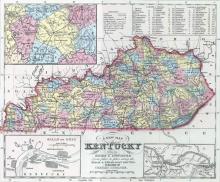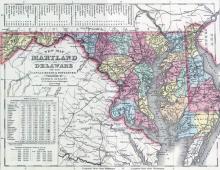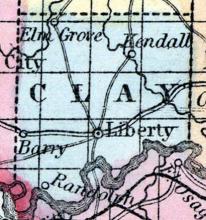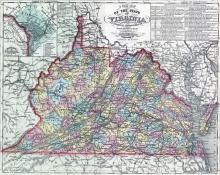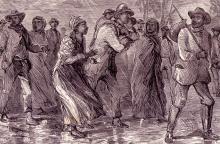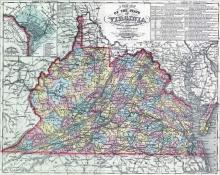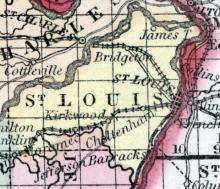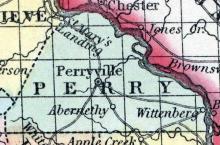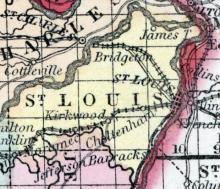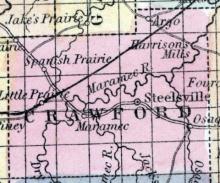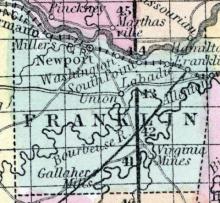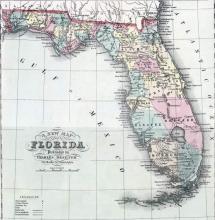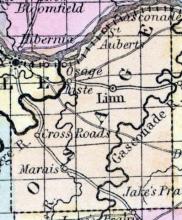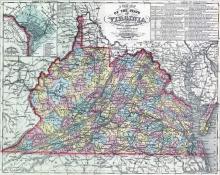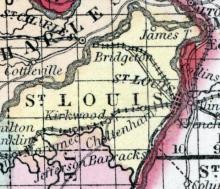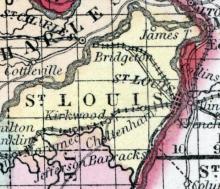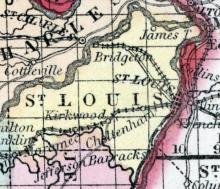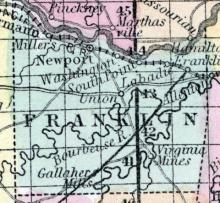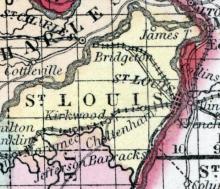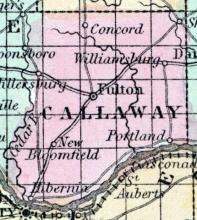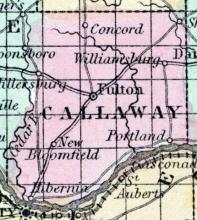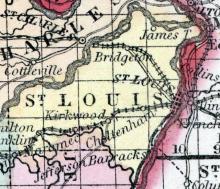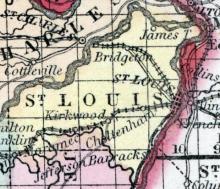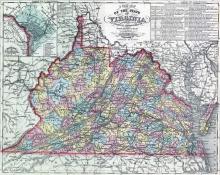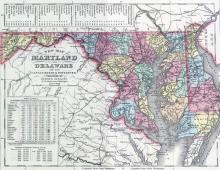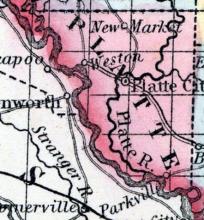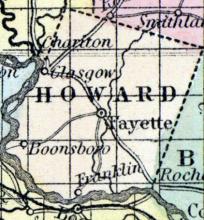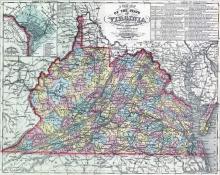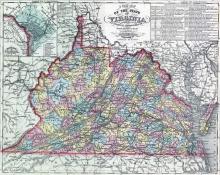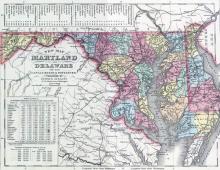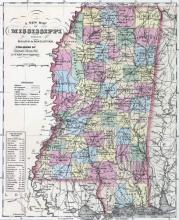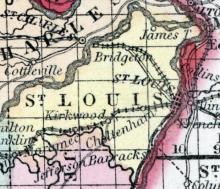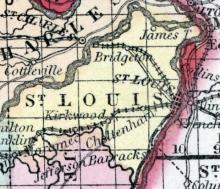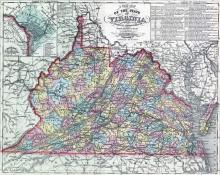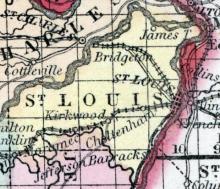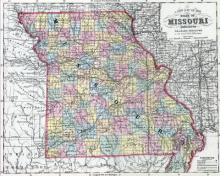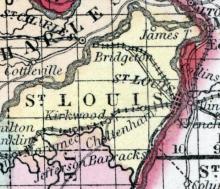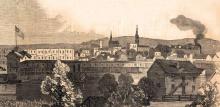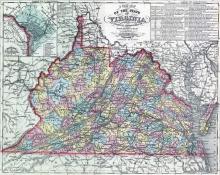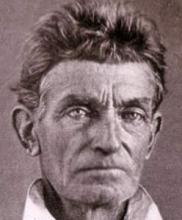An enslaved man named Bill, roughly 22 years in age, escaped from Warrenton, Missouri. His enslaver, W.V. Stewart, advertised a $200 reward for his recapture.
View All Escapes // 1840s // 1850s // 1860s
Displaying 251 - 300 of 476
In early September 1857, some 12 enslaved people escaped from Norfolk, Virginia. Their names were not recorded, though multiple newspapers across the country reported on yet "another negro stampede."
Sometime in early September 1857, an attempted "stampede" was thwarted by local authorities in Petersburg, Virginia. A Philadelphia-bound ship was "suspected of having bargained for the wrong sort of cargo" after authorities got word that several enslaved people were planning to escape from bondage on the boat. The boat was searched at City Point, and the escape was apparently scuttled.
On Sunday, September 6, 1857, eight enslaved people escaped from multiple slaveholders in Loudon county, Virginia. Their ultimate destination and fate remain unknown.
On Thursday, September 17, 1857, a 22-year-old enslaved man named Clarence escaped from St. Louis. His enslaver, E.M. Ryland, offered $200 for his recapture.
On Saturday night, September 19, 1857, an enslaved man named Henry escaped from Fredericktown, Missouri, and was suspected of attempting to cross the Mississippi river "between Ste. Genevieve and Chester." His enslaver, Henry C. Buckner, advertised a $300 reward for his recapture.
On Sunday night, September 20, 1857, a group of 17 enslaved people escaped from Washington, near Maysville, Kentucky. Slave catchers set out in pursuit, and managed to overtake one of the freedom seekers. However, he "battled" his captors bravely, and managed to badly wound two slave catchers before being overcome and hauled off to the Maysville jail. The remainder of the freedom seekers "made their sailing clear," and apparently eluded recapture.
On Wednesday, September 30, 1857, an enslaved man in his mid-20s named Edmund ran away from Mount Helicon (present-day Sullivan) in Franklin county, Missouri. His enslaver, Augustus Wenger, advertised a $150 reward for his recapture.
On the night of Thursday, October 1, 1857, five enslaved people escaped in a horse-drawn wagon from the Bourbon county, Kentucky farm of slaveholder Daniel S. Dillon. The five freedom seekers--three men and two women--made their way to the Ohio river, where they abandoned the horse and wagon and evidently crossed the river by skiff. Dillon set out in pursuit, only to find his wagon and horse abandoned near the river.
Sometime in early October 1857, eleven enslaved people escaped from Carroll county, Maryland. The freedom seekers passed through Carlisle, Pennsylvania on their way to freedom, though they were pursued by a posse of white Marylanders. Their ultimate fate remains unknown.
In early October 1857, a group of four enslaved people, 30-year-old Napoleon, 21-year-old Sandy, 20-year-old John and 23-year-old Dick, escaped from Clay county, Missouri. Their enslavers, Mace Rust and Michael Arthur, offered $1200 for their recapture.
On Sunday night, October 18, 1857, ten enslaved people escaped from Norfolk, Virginia. Their ultimate fate remains unknown.
Throughout late October 1857, some 44 enslaved people escaped from the vicinity of Cambridge, Maryland. That number included a large group of 30, who escaped together on Saturday night, October 24. Slaveholders offered a $3,100 reward for their recapture, but the freedom seekers managed to elude slave catchers.
On Sunday night, November 8, 1857, a family of seven enslaved people--a father, mother, and their five children--escaped from Preston county, Virginia and headed towards Pennsylvania. They were recaptured near Uniontown, Pennsylvania, where despite making a "desperate resistance, fighting with knives, hatchets, &c." the freedom seekers were overpowered.
On either November 17 or 18, 1857, a roughly 28-year-old enslaved woman named Maria escaped, along with her two children, aged 5 and 3 respectively. Their enslaver, John J. Roe, advertised a $100 reward for their recapture.
On December 18, 1857, Sheriff Peter Dean of Perry County, Missouri arrested a twenty-three year old Black man named William Maxfield. Although Maxfield claimed he was free, Dean posted an advertisement indicating that if Maxfield's slaveholder did not come forward and claim him, the man would be sold to cover his jail fees.
On Saturday night, December 19, 1857, a roughly 35-year-old enslaved man named Dave escaped from a property located eight miles outside of St. Louis along the Big Bend Road. His enslaver, John J. Murdoch, promised a "liberal reward" for Dave's recapture.
On Monday, December 28, 1857, a roughly 30-year-old enslaved man named George escaped from a property some nine miles south of Steelville. His enslaver, Joshua Halbert, advertised a $300 reward for his recapture.
On Sunday, January 17, 1858, an enslaved man named Washington, aged about 35 years, ran away from Franklin county, Missouri. His enslaver, J.C. Tevis, suspected Washington had made tracks for Florissant, where his wife lived, advertised a $100 reward for his recapture.
On the night of February 6, 1858, there was a "stampede" of 15 freedom seekers who escaped from Key West, Florida by boat. Local newspapers speculated that the group was heading toward Nassau in the Bahamas.
On March 15, 1858, two enslaved men, Lewis and Ed, escaped from Prior's Mill, along the Gasconade river in Osage County, Missouri. Their enslaver, G.W. Prior, advertised a reward of $100 for their recapture, urging readers to "stop them."
According to the Baltimore Sun, there was an Easter "stampede of slaves" on Sunday, April 4, 1858, involving at least seven from the Mason plantation in Loudon County (near Point of Rocks) and two more from Berkeley County, Virginia.
Two enslaved men who had been hired out near St. Louis, Embay Watson and Jim, ran away. An agent for their enslaver advertised a $400 reward.
Late on Friday night, April 16, 1858, three enslaved women, 42-year-old Milly, 16-year-old Fanny and 19-year-old Eliza, escaped from Central Township in northern St. Louis. Their enslavers suspected that the three women "will attempt to cross the Missouri river at some point between Bellefontaine and St. Charles," and advertised a $750 reward for their recapture.
On Saturday night, June 19, 1858, at least 15 freedom seekers fled Lovettesville, Virginia in a "negro stampede," heading "for parts unknown."
On Sunday, June 20, 1858, a roughly 20-year-old enslaved man named Henry escaped from St. Louis. His enslaver, George Hoyle, advertised a $100 reward for his recapture, positing that Henry was "lurking about his late residence, corner Fourth and Elm streets."
On Monday, June 28, 1858, two enslaved men in their late 20s, Lafayette and Albert, escaped from Union in Franklin county, Missouri. Their enslaver, Edward J. Goode, advertised a $400 reward for their recapture.
On Sunday evening, July 11, 1858, a roughly 26-year-old enslaved man named William Russell escaped from a farm located 10 miles southwest of St. Louis, near Gravois road. Russell's enslaver, Thomas J. Kennedy, advertised a $100 reward for his recapture.
In July 1858, two enslaved men in their early twenties, Jim and John (alias Darby) escaped from a property three miles northeast of Fulton, in Callaway county, Missouri. Their enslaver, Samuel McClure, advertised a $400 reward for their recapture.
On July 16, 1858, an enslaved man named Charles escaped from St. Louis. A thirty year old ropemaker, Charles spoke fluently in English and German. His enslaver, William Humphreys, advertised a $100 reward for Charles's recapture.
On Monday evening, July 19, 1858, an enslaved man named Buck (called Charles by his enslaver) escaped from his slaveholder's house opposite Lafayette Park. His enslaver, William Humphreys, advertised a $100 reward for Buck's recapture.
On Saturday night, July 24, 1858, four Black men escaped from Moorefield, Virginia, allegedly heading toward Pennsylvania. The Richmond Enquirer first reported this story, which was then reprinted in the Charleston SC Courier, under the headline: "Slave Stampede."
In mid-July 1858, there was a reported "slave stampede" from Dorchester County, Maryland, involving six enslaved Blacks from three different owners: Dr. Tubman, Mrs. Dixon and R.L. Phillips.
In late July 1858, an enslaved man named Charles Morehead escaped from Weston, in Platte county, Missouri. His enslaver, Luther Teegarden, suspected that Morehead had "left Liberty Landing on the down trip of the Polar Star," a steamer, and offered a $500 reward for his recapture.
A roughly 25-year-old enslaved man named Jordan escaped from Glasgow on Tuesday morning, August 10, 1858. His enslaver, Garrett W. Morehead, advertised a $200 reward for his recapture.
On Saturday night, August 14, 1858, four Black men escaped from Hampshire County, Virginia in a reported "stampede." A local newspaper noted that the men had stolen four horses, which were eventually found near Cresaptown, Maryland.
On Saturday, August 14, 1858, six enslaved African Americans escaped from Barbour County, Virginia in a reported "slave stampede." Another four freedom seekers from Taylor County joined them on the same night.
On Tuesday, August 31, 1858, ten freedom seekers attempted an escape from West River near Annapolis, Maryland. Two were quickly recaptured but the rest of their group pursued them and after a "bold rush" and a "desperate fight," managed to liberate them temporarily. But according to news accounts, the fight left two Black men in the group "dangerously wounded," which "seemed to frighten and deter the negroes, because they as speedily as possible returned home to the
Senator Stephen A. Douglas of Illinois was married twice. His first wife Martha, who died in 1853, left him ownership of a large cotton plantation in Mississippi. This meant that Douglas, a powerful Democratic senator from a free state, was also a slaveholder in 1858, the year he campaigned against Republican Abraham Lincoln for reelection to the U.S. senate.
On Sunday, September 5, 1858, an enslaved man named Phil escaped from Fenton in St. Louis county, Missouri. His enslaver, Samuel T. Vandover, advertised a $200 reward for his recapture.
Sometime in September 1858, a 25-year-old enslaved man named Willis escaped from St. Louis. His enslaver, Charles McLarin, offered a "liberal reward" for his recapture more than a year later, when his aunt Maria also escaped.
Around Thursday, September 23, 1858, seven freedom seekers from Charlestown, Virginia (now West Virginia) were captured near Chambersburg, Pennsylvania. They were returned to their slaveholders and soon, according to news reports, sold to "purchasers from abroad."
On Sunday, September 26, 1858, a 35-year-old enslaved woman named Jane escaped from St. Louis along with her three children, a 7-year-old boy named Ed, a 4-year-old girl whose name was not recorded, and a 7-month-old infant. Her enslaver, J.H. Gordon, noted that Jane had a husband in Louisville Kentucky, and advertised a $500 reward for the recapture of Jane and her three children.
A group of 9 enslaved people escaped from Missouri, passing through Galesburg, Illinois. Roughly 5-6 of the group made it to freedom.
On Saturday night, October 9, 1858, an enslaved man named Aleck (alias Dock) escaped from Bridgeton, Missouri, opposite St. Charles. His enslaver, Francis St. Cin, initially offered a $200 reward for his recapture, but by November had raised the reward to $1,500.
Around Saturday, October 30, 1858, six freedom seekers ("valued at $7,500") escaped from around Parkersburg, Virginia (now West Virginia) and remained at large. Local newspapers blamed the "stampede," on "free negroes, who are fast getting to be an intolerable nuisance."
Sometime in late October, ten freedom seekers, including five men, three women and two children, escaped from Prunytown, Virginia (now West Virginia) with "seven other chattels in the shape of horses." According to news reports, "They left the horses after the night ride and steered for the North Star on foot," until they were confronted by slave catchers in Fayette County, Pennsylvania. The group then engaged in "a desperate fight for freedom" and ultimately escaped. &
On December 20, 1858, abolitionist John Brown and a group of armed activists led a raid into Vernon county, Missouri, at the behest of enslaved Missourian Jim Daniels who was owned by James Lawrence. The raid freed Daniels, his family and several other enslaved people, 11 in total (12 following the birth of John Brown Daniels), escaping westward through Kansas.

